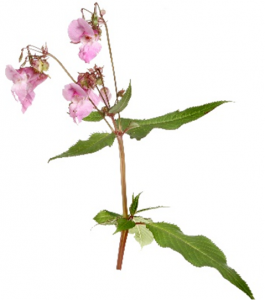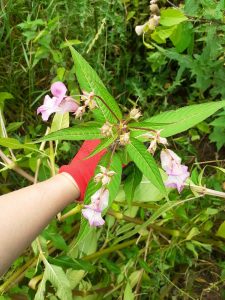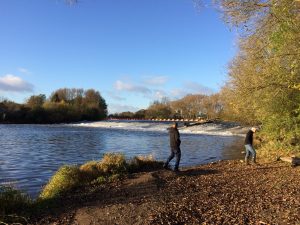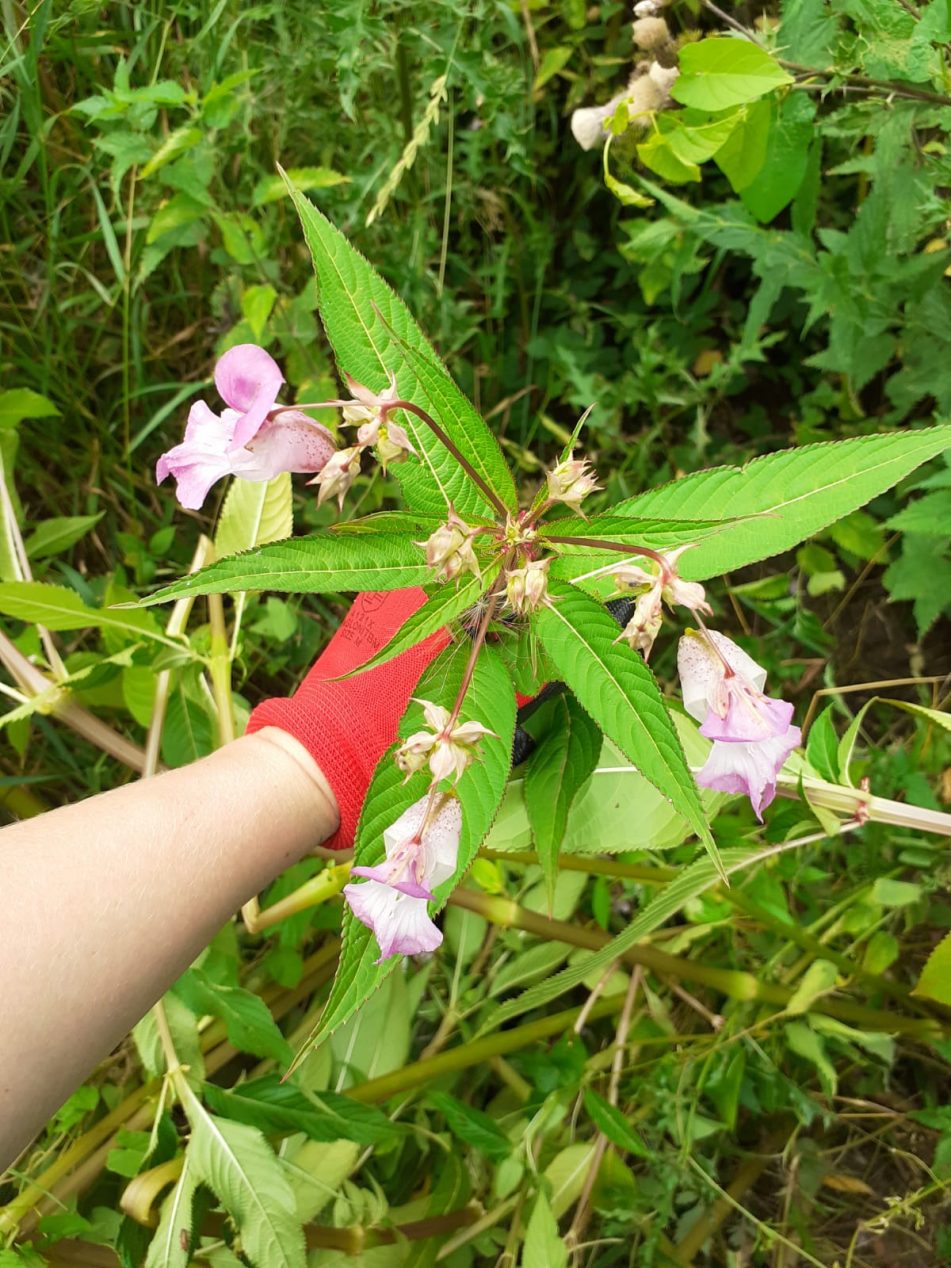
We love the ‘All About’ series, published on the Severn Rivers Trust website. These blogs have been written by Unlocking the Severn volunteers and apprentices, so we figured we’d share them here too! See the original blog on the Severn Rivers website HERE.
Written by Jodie Rochford, a volunteer for Unlocking the Severn and Severn Rivers Trust. Jodie explains the damage caused by this alien invader, and how we can stop it spreading.
What’s Himalayan Balsam?
Himalayan Balsam is a plant that was introduced into the UK from the Himalayas. It was first brought over in 1839 as a garden plant but soon spread across the UK, especially around our waterways [1]. It is now an invasive species that is causing many problems within our ecosystems.
Why is it a problem?
Himalayan Balsam is a fast growing plant that produces up to 800 seeds! These are dispersed about 7 m from the ‘explosive’ seed pods [3]. This effective dispersal method results in dense areas of the plant which grow up to 2.5m high [2] and block out sunlight and space. This in turn prevents other species from growing and greatly reduces plant biodiversity [1].
When the number and variety of plants are reduced in a local area, it means there is a loss in available habitats and food sources for invertebrates. In places where balsam has taken hold, we see around a 75% decrease in spider species, and a 64% decrease in beetle species [5]. Invertebrates are vital for pollination of wild pants and crops, and for maintaining healthy soil structure and fertility. Bugs are also a food source for other animals and are crucial to the cycle of nutrients [4].
Balsam is also a prolific producer of nectar, attracting bees, so they tend to neglect other local plants. This reduces plant fertilisation and production of seeds, diminishing the numbers and varieties of plants locally [5].
One other major issue is that balsam causes riverbank erosion. When the plant dies off in winter, it leaves the riverbank exposed to subsidence and erosion during high water levels. Exposed riverbanks increase the risk of flooding, as riverbank vegetation has a significant role in slowing runoff and flood waters [5].
It is vital that we reduce the spread of Himalayan Balsam to preserve natural riverbank biodiversity and reduce erosion, soil loss and flooding.
How to ID Himalayan Balsam
Himalayan Balsam germination occurs in February and March, with rapid growth in stems and leaves in April [5]. It is visible from spring to autumn and produces flowers between June and October. It is mainly found along waterways, but also in ditches as it can thrive in areas of low light levels [3].
The main identification characteristics of Himalayan Balsam are the stems, flowers, and leaves. The stems are hollow, green-red in colour, and can be 2-3m high. The flowers can be white, pink, or purple and have 5 petals in a helmet/hooded shape. The leaves are serrated and are a matt dark green colour [5].
A member of our team reaches for some flowering Himalayan Balsam.
What can you do to help?
Himalayan Balsam needs to be pulled out in early summer (March to early July) before seed dispersal, as seeds can last up to 3 years [5]. It can be easily removed by pulling the plant out or cutting the stem under the first node. It is not toxic and there are no thorns, so it is safe to be pulled out of the ground by hand [5]. Pulling out the plant will stop the plant from producing the seed pods which will help prevent further spread. Once the plant has been pulled out, it can be left on the ground to naturally biodegrade [5]. It is important to keep safe if you are pulling balsam, do not attempt to reach plants on steep sided banks or close to the water’s edge.
Seeds can travel down waterways by attaching themselves to vehicles, clothing, or footwear [5]. Therefore it is important to check your clothes and footwear before travelling to a different area – Check, Clean, Dry.
Get involved with Unlocking the Severn!
Unlocking the Severn works closely with Bewdley Civic Society, near Worcester. The Civic Society have been helping to control the spread of Himalayan Balsam in this area for the past 6 years! The group meet each summer to do ‘Balsam Bashes’ in July and always welcome additional volunteers to help control this harmful plant species.
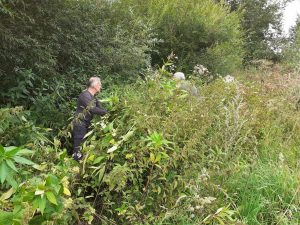
Lost in the undergrowth! Some of our volunteers ‘balsam bashing’ in Bewdley.
Unlocking the Severn have worked closely with Bewdley Civic Society during their Summer ‘Balsam Bashing’ events. The Civic Society have been helping to control the spread of Himalayan Balsam in this area for the past 6 years! If you are local to the Bewdley area, keep your eyes open for information posters for how to get involved with them.
If you would like to be kept up to date with Unlocking the Severn volunteering programs, please visit the volunteering page of our website HERE and scroll down to the bottom where you can register your interest in a wide variety of activities.
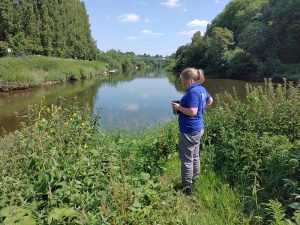
One of our volunteers taking a break in the gorgeous setting of Holt Lock Island.
References:
1. The WildlifeTrusts. 2021. Himalayan balsam | The Wildlife Trusts. [online]Available at: <https://www.wildlifetrusts.org/wildlife-explorer/wildflowers/himalayan-balsam>[Accessed 25 April 2021].
2. National Trust.2021. Himalayan Balsam – it’s an alien plant invasion. [online]Available at: <https://www.nationaltrust.org.uk/features/himalayan-balsam–its-an-alien-plant-invasion>[Accessed 25 April 2021].
3. RoyalHorticultural Society. 2021. Himalayan balsam. [online] Availableat: <https://www.rhs.org.uk/advice/profile?pid=480> [Accessed 25 April2021].
4. Scudder, G., 2017. Insect Biodiversity:Science and Society. 2nd ed. John Wiley & Sons, Inc.
5. Inside Ecology.2021. Invasive non-native species (UK) – Himalayan balsam – InsideEcology. [online] Available at: <https://insideecology.com/2017/10/19/invasive-non-native-species-uk-himalayan-balsam/>[Accessed 25 April 2021].
6. Fish Pass.2021. Fish Pass – Contact. [online] Available at:<https://fishpassapp.co.uk/biosecurity> [Accessed 5 May 2021].
7. Norfolkwildlifetrust.org.uk.2021. Himalayan balsam. [online] Available at:<https://www.norfolkwildlifetrust.org.uk/wildlife-in-norfolk/species-explorer/plants/himalayan-balsam>[Accessed 8 May 2021].
8. Environet UK. 2020. IdentifyHimalayan Balsam| Environet. [online] Available at: <https://environetuk.com/identify-himalayan-balsam>[Accessed 8 May 2021].

